LEARNING THE BASICS OF "CLEAN PULLS AND CLEANS".
By: J.V. Askem, THE CABLE/ BAR GUY.
THE CLEAN PULL
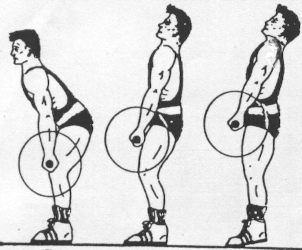
Fig. 1
Fig. 2
Fig.3
The actual "Clean" or "Second" Pull doesn't really starts until
the bar reaches a height above the knees as shown above (Fig. 1). The first
portion of the lift, up to that point, when performed from the floor, is
nothing more than a Deadlift. (NOTE: Refer to the article "The Romanian
Deadlift (RDL) for proper back, hip, and leg positioning when pulling off
of the floor.)
Once the bar has reached a height above the knees (Fig. 1) then the
second pull begins. This is done by grazing the bar up the thighs as your
hips move forward on a horizontal plane. (NOTE: Do not bump or bounce the
bar against the thighs. This could cause the bar to change direction out
of its normal straight line upward path.
When your body is in an upright position (Fig. 2) initiate a shrug
straight upward with your shoulders and traps. Now, the thigh graze and
the shrug must be performed in an explosive manner to get the most acceleration
of the bar. At the top end of your clean pull your shoulders should be
fully shrugged all the way up to your ear lobes (Fig. 3).
THE POWER AND SQUAT CLEAN
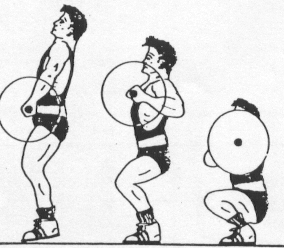
Fig. 4
Fig. 5
Fig. 6
To execute a clean from a full extended pull position you must drop
down under the bar when its upward travel stops. This in most cases is
done by doing a partial or full front squat. In rare cases some lifters
perform a split under the bar.
THE DOUBLE KNEE BEND STYLE OF PULL!!!
Now many times when executing a clean, to get a little extra height
on the bar, you can add a jump in along with the thigh graze and the shrug.
If you're a jumper, your jump should be initiated at the Fig. 3 position.
To jump before that position will throw the bar out away from your body.
Now the most efficient way to execute a "jump style of pull" is to
rebend your legs as you finish your thigh graze. Such a style is referred
to as the "double knee bend style" of pull. This style can then allow you
to get a partial squatting action also into your jump. The best body leverage
for such a technique is a long trunk and short legs. Long armed and short
trunked individuals will have more difficulty executing the double knee
bend style of pull.
photo 1
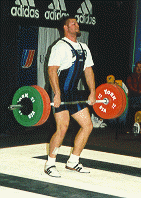
Jesse Marunde rebending
his legs under the bar to
intiate a jump as part of
his second pull.
POWER CLEANS
When racking the bar onto your shoulders for a clean, if caught
at a half squat (Fig. 5) or higher it is generally referred to as a power
clean. If you have to ride the weight down, or you have to squat fully
to catch the bar, then you would be doing a squat clean. The catch position
for a power clean or a squat clean requires an upright position of your
upper body (Fig. 6). So it is important to maintain flexibility in the
areas of your ankles, knees, hips, and spine.
HANG CLEANS
Over the years the term clean "from the hang" has had several interpretations.
In most weightlifting circles nowadays, "from the hang" usually means from
above the knees or from the Fig. 1 position. Fig. 1 could also be referred
to as the "high hang" position. If this is the case then the "low hang"
would be from below the knees but not where the weights touch the floor.
Low Hang Cleans are usually done from the mid shin area.
WHERE DOES THE CLEAN PULL FIT IN?
As an Olympic lifting coach, I've always felt that the best way
to teach an Olympic lifting movement is the dissect the lifts into segments.
When doing so with a clean, I've found that using Romanian Deadlifts, Clean
Pulls, and Front Squats to be the best three exercises for this purpose.
Now, of the three aforementioned exercises, the second pull segment
is the most difficult to learn. This is because two compound movements
are used. Check the four pictures below! There you can see that a partial
deadlift is run into a shrug. Also it is imperative that this be timed
properly as well as being performed as explosively as possible. Only then
will the bar reach its maximum height.
HIGH AND LOW CLEAN PULLS.
When incorporating "clean pulls" into your training schedule, first
analyze your goals and motives. For example, if your cleaning technique
is flawed to the point of being dangerous, it would be wise if you just
use the "clean pull" as your main second pull power movement! Save the
clean itself for just light technique practice sessions.
Also when doing clean pulls two heights should be considered. The
"low pull" position is the usually around belt height, and this is an indicator
of the minimum height needed for a squat clean catch position. When performing
low clean pulls the weights handled are usually between 90% to 110% of
your best squat clean.
Now to execute a power clean a higher catch position must be obtained!
So a "high pull" position closer to sternum needs to be obtained. High
clean pulls are generally 6" to 8" higher than low clean pulls.
HEIGHT GAUGE
Now to let a lifter know that they are getting a full extension
at the top end of their pulls, a "height gauge" is recommended! To illustrate
this, my training partner, George Farren is clean pulling from start to
finish. NOTE: On the left side of each picture below, you can see a bunge
cord stretched across the uprights of one of the rack's towers. When George
pulls the bar up, if he gets the proper extension, the bar will hit the
bunge cord and a small bell that is attached will jingle. This will then
signal that the proper pulling height was reached.
As a point of interest, George Farren never lifted a barbell until
he was 57 years old. Prior to that he had had both knees operated on, and
when he started he could not squat a 45 lb. empty bar. Within a year of
training he was squatting 300 lbs with no supports.
photo 2
photo 3
photo 4
photo 5
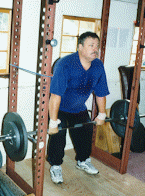
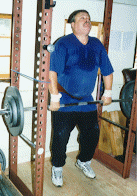
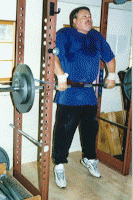
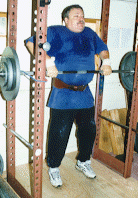
George Farren shows good form on clean pulls. Note the shoulders shrugged
up to the ear lobes, and as he follows through, his elbows are kept pointing
up. In this example George has his height gauge set for the "high clean"
pull
position. Learning these pulling positions, both high and low, will prepare
the inexperienced lifter for full power or squat cleans later on.
FREQUENTLY ASKED QUESTIONS ABOUT HIGH PULLS???
(1) Do I also pull with my biceps of my arms as illustrated on
photo 3?
(Answer) No! The bent bent arm position that George has in photos
4&5 is just a follow through from the momentum of his second pull.
All the pulling action on Olympic style pulls (snatch or clean) should
initiated by the large muscle groups, namely the glutes, hamstrings, spinal
erectors, and traps.
(2) Do I try to resist the bar when I put it down?
(Answer) No! Just let the bar free fall to the racks' pins or
to the floor if you started from the floor.
(3) How many sets and reps are recommended on High Pulls?
(Answer) When performing any multiple compound movement or Olympic
lift it is not recommended that over 3 reps per set be performed. This
is because technique is of the utmost importance and fatigue from too many
reps will compromise that technique.
As far as sets goes, that will depend upon the percentage (%)
of maximum being performed. Generally 7 to 12 sets will suffice. Work up
on the first 3 to 5 sets to a work weight and then concentrate on technique
on the remaining sets. Always try to shrug the shoulders to ear lobe height
and try to keep your elbows pointing in a upward direction.
BACK
TO THE CABLE/ BAR GUY'S HOME PAGE.
LEARNING
THE BASICS cont'd SNATCHES AND SN. PULLS
PACIFIC
NORTHWEST LIFTERS' CORNER.






